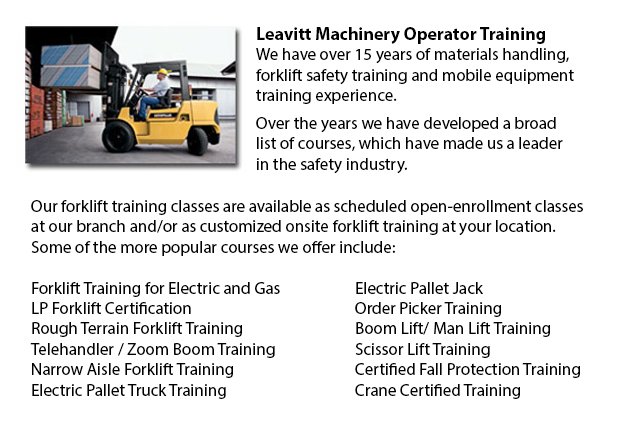
Nanaimo Forklift Training Program - The lift truck is a common powered industrial vehicle that is in wide use nowadays. They are occasionally referred to as jitneys, hi los or lift trucks. A departments store will utilize the forklift to be able to unload and load products, while warehouses would make use of them to be able to stack materials and products. And grocery stores use small models to drop supplies in the aisles. Whether transporting lumber at a sawmill or loading material at a construction site, operators of forklifts should be properly trained and licensed. The main concern should be on the safety of the worker and pedestrian. This lift truck training program teaches the safety and health regulations governing forklifts to be able to ensure their safe and efficient use.
Forklift Training Program Safety Guidelines:
Correct training guarantees that forklift operators could maintain control of the lift truck in tilting, traveling and lifting. Just qualified operators should drive a forklift.
When the forklift is in use; arms, hands, head, legs and feet should be kept inside the forklift. Lift truck forks must be kept low to the ground while being slightly tilted back. Observe posted traffic signs. Honk the horn and lessen speed if taking a corner. If the driver's vision is blocked by the load, slowly drive in reverse. Pre-inspect the ground for possible hazards, such as wet or oily spots, objects, rough patches, holes, people and vehicles. Prevent stopping suddenly.
If pedestrians pass across the vehicle or moves into a blind spot, the forklift should be stopped, the load lowered, waiting until the way is clear. If a load is being transported on an incline, the forks must be pointed uphill with a load and downhill without a load. The forklift must only be turned around if on level ground.
Safety guidelines when steering - If traveling at good speeds, never turn the steering wheel sharply. Support the load with the front wheels and turn utilizing the back wheels. An overloaded truck will be difficult to steer. Follow load limits. Never add a counterweight as a way to improve steering.
Safety guidelines while loading - Adhere to the suggested load and capacity restrictions of the lift truck. This information is displayed on the data plate. Always make certain that the load is positioned according to the recommended load centre. The forklift would remain stable so long as the load is kept close to the front wheels.
Before inserting the forks into the pallet, the forklift mast must be in an upright position. Level the forks prior to inserting them.
-
Nanaimo Boom Lift Certification
Nanaimo Boom Lift Certification - Using elevated work platforms allow for maintenance operations and work to be carried out at elevated work heights which were otherwise not reachable. Workers making use of scissor lifts and boom lifts can learn how... More -
Nanaimo Boom Lift Safety Training
Nanaimo Boom Lift Safey Training - Boom lifts are a kind of aerial lifting device or elevated work platform which are commonly used in industry, warehousing and construction. Boom lifts could be utilized in practically whichever environment because o... More -
Nanaimo Loader Operator Training
Nanaimo Loader Operator Training - Loader Operator Training - Forklift training is a prerequisite within North America and is intended to prevent workplace death and injuries. Lift truck training provides driver training intended for forklift operato... More -
Fall Protection Certification in Nanaimo
There are high numbers of injuries at work associated to falling and lots of fall-related deaths reported each and every year. Most of these instances might have been prevented with better training, better measures in place, and by properly equipping... More -
Nanaimo Crane Ticket
Nanaimo Crane Ticket - The modern version of a crane can be either complex or simple, and cranes vary based on their use. Mobile cranes, for example are rather simple. A telescopic boom or steel truss mounts its movable platform. A system of levers o... More -
Operator Safety Certification | Re-Qualification Certification | In-House Instructor Certification in Nanaimo
Lift trucks are used in practically all industrial construction sites and in warehouse operations and in boat yards. The reach feature of a forklift is a very important part utilized in several applications like when a shelving system is being used t... More -
Aerial Lift / Boom Lift / Man Lift / Scissor Lift Certification in Nanaimo
Scissor hoists are lift tables which lift up materials and individuals and supplies vertically. They are normally used in construction, commercial and industrial environments. A common use of scissor hoists is for lowering or lifting construction sup... More -
Crane / Overhead Crane / Self-Erect Crane / Truck Mounted Crane / Hydraulic Cranes Certification in Nanaimo
Bridge cranes or likewise called overhead cranes are a type of industrial material handling crane utilizing a line and hook apparatus that runs on a horizontal beam running along two widely separated rails. Several overhead cranes can be seen inside... More

Forklift Certification Nanaimo
TOLL FREE: 1-888-254-6157
Nanaimo, British Columbia
forkliftcertificationnanaimo.com
Email Us
About Us


